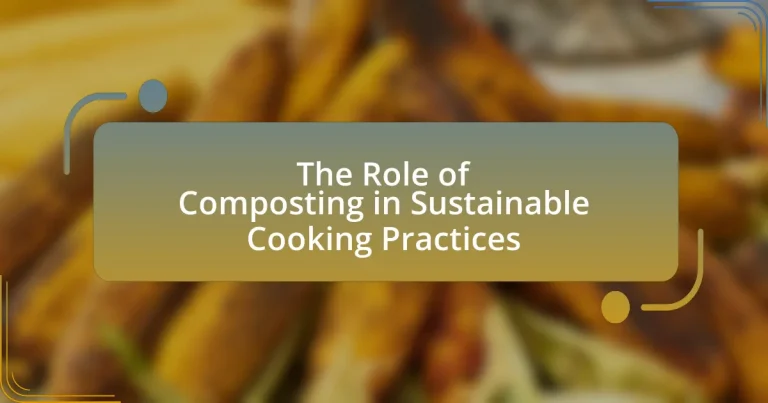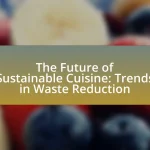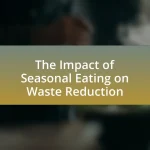Composting is a vital practice in sustainable cooking, transforming organic kitchen waste into nutrient-rich soil amendments while significantly reducing landfill contributions and greenhouse gas emissions. This article explores the environmental benefits of composting, including its role in enhancing soil health and supporting local food systems. It also addresses common misconceptions, practical tips for effective composting, and the skills home cooks can gain from integrating composting into their daily routines. By understanding the importance of composting, cooks can contribute to a more sustainable culinary environment and promote eco-friendly practices.
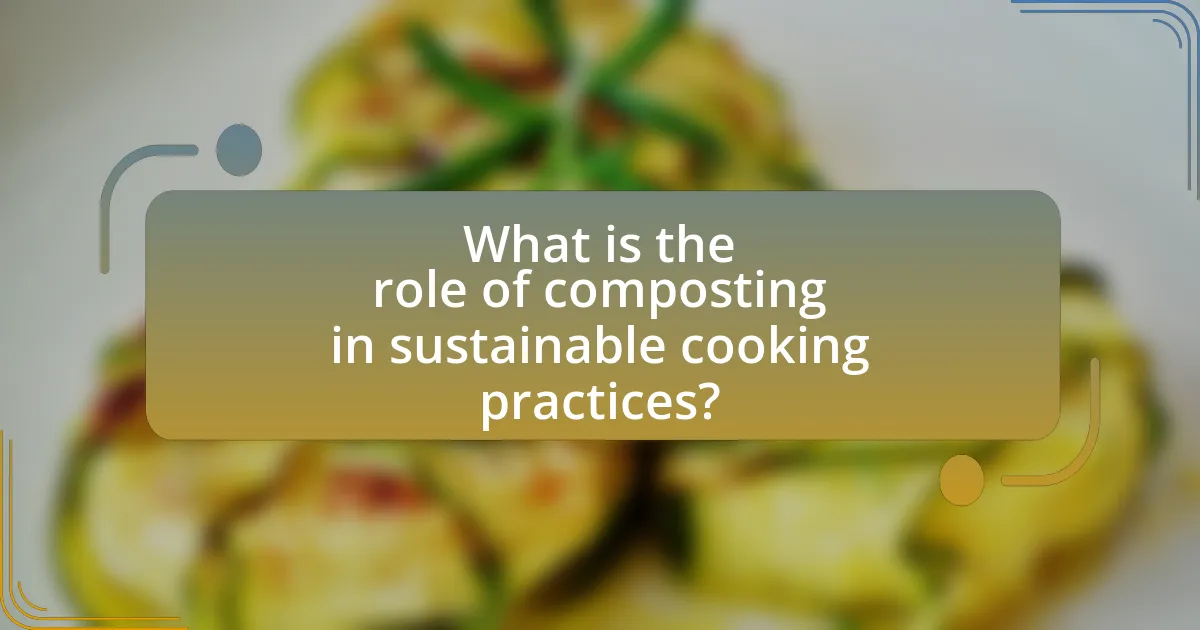
What is the role of composting in sustainable cooking practices?
Composting plays a crucial role in sustainable cooking practices by transforming organic kitchen waste into nutrient-rich soil amendments. This process reduces landfill waste, which accounts for approximately 30% of total waste, and minimizes greenhouse gas emissions associated with waste decomposition. By composting, cooks can recycle food scraps, such as vegetable peels and coffee grounds, thereby closing the loop in food production and consumption. Furthermore, compost enriches soil health, promoting sustainable agriculture and reducing the need for chemical fertilizers, which can harm the environment.
How does composting contribute to sustainability in cooking?
Composting contributes to sustainability in cooking by reducing food waste and enriching soil health. When organic kitchen scraps are composted instead of sent to landfills, they decompose naturally, minimizing methane emissions—a potent greenhouse gas. According to the Environmental Protection Agency, food waste accounts for approximately 22% of municipal solid waste, highlighting the significant impact composting can have on waste reduction. Additionally, compost improves soil structure, fertility, and moisture retention, which supports sustainable agriculture practices and reduces the need for chemical fertilizers. This cycle of recycling nutrients back into the soil fosters a more sustainable cooking environment by promoting local food production and reducing the carbon footprint associated with transporting food.
What are the environmental benefits of composting in the kitchen?
Composting in the kitchen significantly reduces waste sent to landfills, thereby decreasing methane emissions, a potent greenhouse gas. When organic waste decomposes in landfills, it produces methane, which is 25 times more effective at trapping heat in the atmosphere than carbon dioxide over a 100-year period. By composting, households can divert approximately 30% of their waste, contributing to lower overall landfill volumes and reducing the environmental impact associated with waste management. Additionally, composting enriches soil, promotes biodiversity, and reduces the need for chemical fertilizers, which can harm ecosystems. Studies indicate that compost can improve soil structure and water retention, leading to healthier plants and reduced irrigation needs.
How does composting reduce food waste in cooking practices?
Composting reduces food waste in cooking practices by transforming organic kitchen scraps into nutrient-rich soil amendments, thereby diverting waste from landfills. When individuals compost, they actively recycle food waste, such as vegetable peels and fruit cores, which would otherwise contribute to landfill mass and methane emissions. According to the Environmental Protection Agency, food waste accounts for approximately 22% of municipal solid waste, highlighting the significant impact of composting in reducing this figure. By composting, households can minimize their overall waste output while enriching their gardens or plants with compost, thus promoting sustainable cooking practices.
Why is composting important for home cooks?
Composting is important for home cooks because it reduces kitchen waste and enriches soil, promoting sustainable cooking practices. By composting organic scraps like vegetable peels and coffee grounds, home cooks can divert approximately 30% of their household waste from landfills, which significantly lowers greenhouse gas emissions. Additionally, compost provides essential nutrients to gardens, enhancing plant growth and reducing the need for chemical fertilizers. This practice not only supports environmental health but also fosters a circular food system, where waste is transformed into valuable resources for future meals.
What skills do home cooks gain from composting?
Home cooks gain skills in waste management, resourcefulness, and environmental awareness from composting. By composting, they learn to effectively manage kitchen scraps and organic waste, reducing landfill contributions. This practice fosters resourcefulness as cooks find creative ways to utilize food scraps, such as making broths or vegetable stocks. Additionally, composting enhances environmental awareness, as cooks understand the benefits of returning nutrients to the soil, promoting sustainable gardening practices. These skills contribute to a more sustainable cooking approach, aligning with eco-friendly practices.
How can composting enhance the quality of home-cooked meals?
Composting enhances the quality of home-cooked meals by providing nutrient-rich organic matter that improves soil health and promotes the growth of healthier vegetables and herbs. When compost is added to garden soil, it increases its fertility, water retention, and microbial activity, leading to more robust plant growth. Research indicates that vegetables grown in compost-enriched soil have higher levels of vitamins and minerals, which directly contributes to the nutritional value of meals prepared with these ingredients. For example, a study published in the Journal of Environmental Quality found that tomatoes grown in compost had significantly higher levels of antioxidants compared to those grown in conventional soil. This nutrient boost from composting ultimately results in more flavorful and nutritious home-cooked meals.
What types of materials can be composted in cooking?
Organic kitchen waste can be composted in cooking, including fruit and vegetable scraps, coffee grounds, eggshells, and plant-based food leftovers. These materials are rich in nitrogen and carbon, which are essential for creating nutrient-rich compost. According to the U.S. Environmental Protection Agency, composting food scraps can significantly reduce landfill waste and contribute to soil health, making it a sustainable practice in cooking.
Which kitchen scraps are ideal for composting?
Ideal kitchen scraps for composting include fruit and vegetable peels, coffee grounds, eggshells, and leftover grains. These materials are rich in nitrogen and carbon, essential for creating nutrient-dense compost. For instance, fruit and vegetable scraps contribute moisture and nutrients, while coffee grounds add nitrogen, promoting microbial activity. Research indicates that composting these organic materials can reduce landfill waste by up to 30%, supporting sustainable cooking practices.
How do different composting methods affect the materials used?
Different composting methods significantly influence the types of materials that can be effectively processed. For instance, traditional aerobic composting requires a balanced mix of green materials (nitrogen-rich) and brown materials (carbon-rich), allowing for a diverse range of kitchen scraps, yard waste, and paper products to decompose efficiently. In contrast, vermicomposting, which utilizes worms, is particularly effective for softer organic materials like fruit and vegetable peels, but less suitable for tougher materials such as woody stems or large quantities of dairy and meat, which can harm the worms. Anaerobic composting, on the other hand, can handle a broader range of materials, including those that are not suitable for aerobic methods, such as meat and fats, but may produce odors and require careful management to avoid issues. These differences in composting methods dictate the selection and preparation of materials, ultimately affecting the efficiency and quality of the compost produced.
How can composting practices be integrated into daily cooking routines?
Composting practices can be integrated into daily cooking routines by designating a specific container for food scraps and organic waste during meal preparation. This container should be easily accessible in the kitchen, allowing for the immediate disposal of vegetable peels, fruit cores, and other compostable materials. Research indicates that approximately 30% of the waste generated in households is organic, which can be diverted from landfills through composting, thus reducing greenhouse gas emissions and enriching soil health. By consistently using this container, individuals can develop a habit of composting, contributing to sustainable cooking practices and minimizing food waste.
What challenges do cooks face when starting to compost?
Cooks face several challenges when starting to compost, including a lack of knowledge about composting methods, difficulty in managing compost materials, and concerns about odors and pests. Many cooks are unfamiliar with the types of organic waste suitable for composting, which can lead to improper composting practices. Additionally, managing the balance of green and brown materials is crucial; without this knowledge, compost can become too wet or too dry, hindering the decomposition process. Odors and pests are common concerns, as improper composting can attract unwanted insects and create unpleasant smells, deterring cooks from maintaining their compost systems. These challenges highlight the need for education and resources to support cooks in adopting effective composting practices.
How can these challenges be overcome effectively?
To effectively overcome challenges in composting for sustainable cooking practices, implementing education and community engagement is essential. Educating individuals about the benefits and methods of composting increases participation and reduces misconceptions. For instance, studies show that communities with active composting education programs see a 30% increase in composting rates. Additionally, providing accessible resources, such as local composting workshops and online guides, empowers individuals to start composting at home. Engaging local governments to support composting initiatives through incentives or infrastructure improvements further enhances participation and effectiveness.
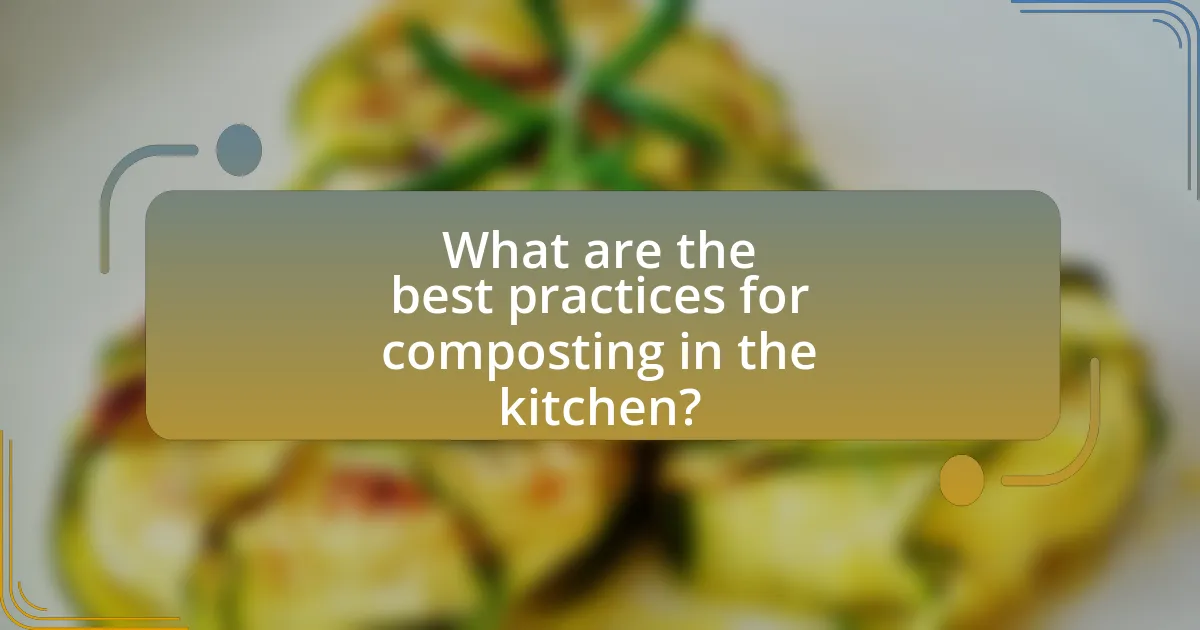
What are the best practices for composting in the kitchen?
The best practices for composting in the kitchen include separating compostable materials, maintaining a balanced mix of greens and browns, and regularly turning the compost. Kitchen composting should start with collecting fruit and vegetable scraps, coffee grounds, eggshells, and yard waste while avoiding meat, dairy, and oily foods to prevent odors and pests. A balanced mix of nitrogen-rich greens (like vegetable scraps) and carbon-rich browns (like dried leaves or paper) accelerates decomposition. Regularly turning the compost every few weeks aerates it, promoting faster breakdown and reducing odors. These practices ensure efficient composting, contributing to sustainable cooking by reducing food waste and enriching soil.
How can cooks maintain an effective composting system?
Cooks can maintain an effective composting system by regularly monitoring the balance of green and brown materials, ensuring proper aeration, and maintaining appropriate moisture levels. Green materials, such as vegetable scraps and coffee grounds, provide nitrogen, while brown materials, like dried leaves and cardboard, supply carbon. A ratio of approximately 2:1 green to brown materials is optimal for decomposition. Additionally, turning the compost pile every few weeks enhances aeration, which accelerates the breakdown of organic matter. Maintaining moisture is crucial; the compost should feel like a damp sponge, requiring occasional watering if it becomes too dry. These practices ensure a healthy composting environment, leading to nutrient-rich compost that supports sustainable cooking practices.
What are the key factors for successful composting?
The key factors for successful composting include the right balance of carbon and nitrogen, adequate moisture, proper aeration, and the use of diverse organic materials. Maintaining a carbon-to-nitrogen ratio of approximately 30:1 promotes efficient microbial activity, which is essential for decomposition. Moisture levels should be kept between 40-60% to support microbial life without causing anaerobic conditions. Proper aeration, achieved through turning the compost regularly, ensures oxygen availability, which is crucial for aerobic decomposition. Additionally, incorporating a variety of organic materials, such as kitchen scraps, yard waste, and paper products, enhances nutrient diversity and accelerates the composting process. These factors collectively contribute to the effectiveness and efficiency of composting, leading to high-quality compost.
How often should compost be turned or maintained?
Compost should be turned or maintained every 1 to 2 weeks to ensure proper aeration and decomposition. Regular turning introduces oxygen, which is essential for aerobic microorganisms that break down organic matter efficiently. Research indicates that maintaining this frequency can accelerate the composting process, resulting in finished compost in as little as 4 to 6 weeks, compared to longer periods without regular maintenance.
What tools and resources are available for kitchen composting?
Kitchen composting can be facilitated by several tools and resources, including compost bins, kitchen scrap containers, and composting worms. Compost bins, such as tumblers or stationary bins, provide a designated space for organic waste to decompose. Kitchen scrap containers, often with airtight lids, help collect food scraps conveniently before transferring them to the compost bin. Additionally, vermicomposting systems utilize worms to break down organic material efficiently, producing nutrient-rich compost. Resources such as local composting workshops, online guides, and community composting programs further support individuals in implementing effective kitchen composting practices.
Which compost bins are most suitable for home kitchens?
The most suitable compost bins for home kitchens include countertop compost bins, worm composters, and small outdoor compost bins. Countertop compost bins are designed for easy access and odor control, making them ideal for collecting kitchen scraps like vegetable peels and coffee grounds. Worm composters, or vermicomposting systems, utilize red wigglers to break down organic waste efficiently, producing nutrient-rich compost in a compact space. Small outdoor compost bins, such as tumblers or bins with aeration features, allow for larger quantities of kitchen waste and can accelerate the composting process. These options are validated by their widespread use in urban and suburban settings, where space and convenience are critical for effective composting.
What online resources can help beginners with composting?
Online resources that can help beginners with composting include websites like the EPA’s Composting page, which provides guidelines and tips for effective composting, and the Rodale Institute, known for its extensive research on organic farming and composting techniques. Additionally, the Composting 101 section on the National Resources Defense Council (NRDC) website offers practical advice tailored for novices. These resources are credible as they are backed by environmental agencies and organizations dedicated to sustainable practices, ensuring that beginners receive accurate and actionable information.
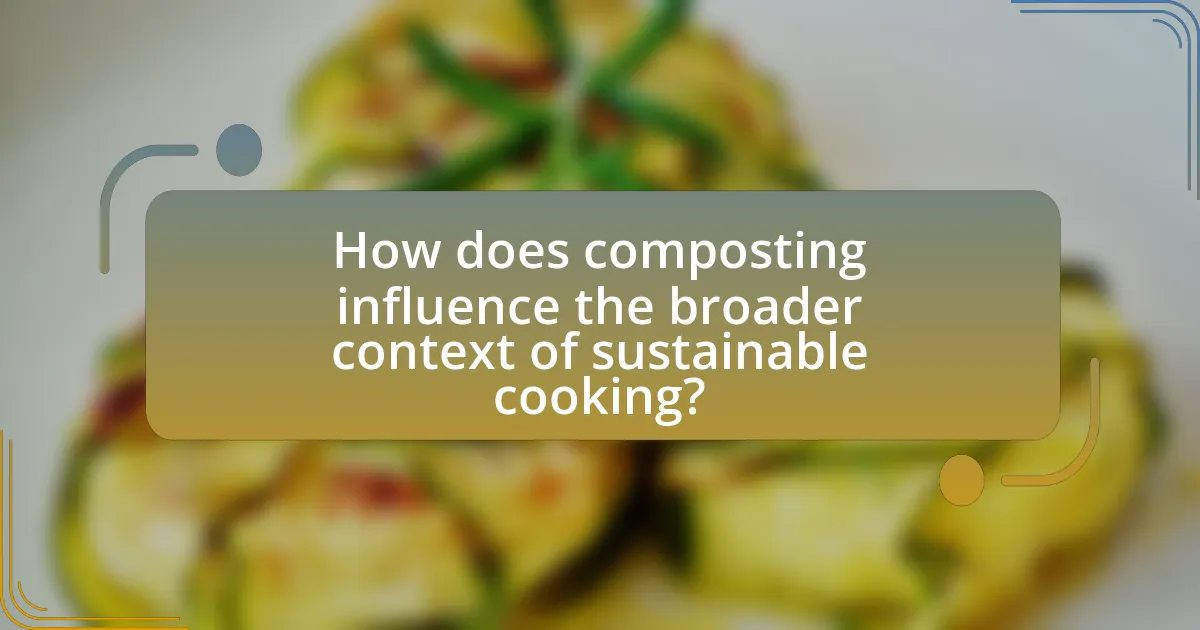
How does composting influence the broader context of sustainable cooking?
Composting significantly enhances sustainable cooking by reducing food waste and enriching soil health. When organic kitchen scraps are composted, they transform into nutrient-rich compost that can be used to grow food, thereby closing the loop in food production. According to the Environmental Protection Agency, composting can divert approximately 30% of waste from landfills, which not only reduces methane emissions but also promotes a circular economy. This practice encourages cooks to be more mindful of their food sources and waste, fostering a culture of sustainability in culinary practices.
What role does composting play in reducing the carbon footprint of cooking?
Composting significantly reduces the carbon footprint of cooking by diverting organic waste from landfills, where it would otherwise produce methane, a potent greenhouse gas. When food scraps and other organic materials are composted, they decompose aerobically, which emits far less carbon dioxide compared to anaerobic decomposition in landfills. According to the Environmental Protection Agency, composting can reduce methane emissions by up to 50% from organic waste. Additionally, composting enriches soil, which can enhance plant growth and reduce the need for chemical fertilizers, further lowering carbon emissions associated with food production.
How does composting support local food systems?
Composting supports local food systems by recycling organic waste into nutrient-rich soil amendments, which enhances soil health and fertility. Healthy soil promotes robust plant growth, leading to increased agricultural productivity for local farmers. According to a study published in the Journal of Environmental Quality, compost application can improve crop yields by up to 30% compared to conventional fertilizers. This boost in productivity not only benefits local farmers economically but also contributes to food security within the community by increasing the availability of fresh produce.
What impact does composting have on community sustainability initiatives?
Composting significantly enhances community sustainability initiatives by reducing waste and promoting resource recycling. It diverts organic materials from landfills, which can account for up to 30% of municipal solid waste, thereby decreasing greenhouse gas emissions associated with waste decomposition. Furthermore, composting enriches soil health, leading to improved agricultural productivity and reduced reliance on chemical fertilizers. Studies show that communities implementing composting programs can see a reduction in waste disposal costs and an increase in community engagement around sustainability practices, fostering a culture of environmental responsibility.
What are some common misconceptions about composting in cooking?
Common misconceptions about composting in cooking include the belief that composting is only for garden waste, that it attracts pests, and that all food scraps can be composted without consideration. Composting is not limited to garden waste; kitchen scraps like vegetable peels, coffee grounds, and eggshells can also be composted effectively. Additionally, while some pests may be attracted to compost, proper management and maintaining a balanced compost pile can minimize this issue. Lastly, not all food scraps are suitable for composting; items like meat, dairy, and oily foods can create odors and attract pests, making them unsuitable for home composting.
How can these misconceptions be addressed?
Misconceptions about composting can be addressed through education and awareness campaigns that provide accurate information about its benefits and processes. For instance, workshops and online resources can clarify that composting reduces food waste, enriches soil, and lowers greenhouse gas emissions. Research from the Environmental Protection Agency indicates that composting can divert approximately 30% of waste from landfills, demonstrating its significant impact on sustainability. By disseminating factual data and practical guidance, individuals can better understand composting’s role in sustainable cooking practices.
What practical tips can enhance composting efforts in cooking?
To enhance composting efforts in cooking, one practical tip is to separate kitchen scraps effectively, ensuring that only compostable materials like vegetable peels, fruit scraps, and coffee grounds are included. This practice is crucial because it reduces contamination and accelerates the composting process, as these organic materials decompose more efficiently. Additionally, maintaining a balanced ratio of green materials (nitrogen-rich) and brown materials (carbon-rich) in the compost pile is essential; a recommended ratio is 2:1 green to brown. This balance promotes optimal microbial activity, which is vital for decomposition. Furthermore, regularly turning the compost pile improves aeration, which speeds up the breakdown of materials. Studies show that well-aerated compost piles can decompose organic matter up to 30% faster than those that are not turned.
